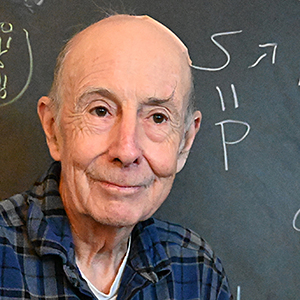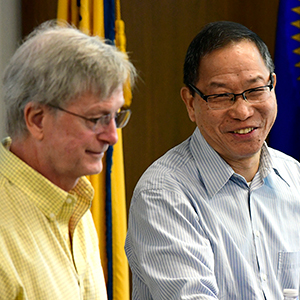At the Environmental Mutagenesis and Genomics Society (EMGS) annual meeting Sept. 22-25, attendees focused on associations between exposure to toxic agents and the development of cancer. Although researchers’ understanding of that disease is well developed, shedding light on the specific biological links between a given exposure and cancer progression is difficult.
Participants also explored topics ranging from scientific tools for studying genetic mutations to the broader implications of federal cancer research funding. Several NIEHS scientists and grant recipients shared their research.
Early epigenetic changes, later-life risk
 Walker, shown here sharing her research during a 2019 NIEHS Distinguished Lecture, directs the Center for Precision Environmental Health at Baylor. (Photo courtesy of Steve McCaw / NIEHS)
Walker, shown here sharing her research during a 2019 NIEHS Distinguished Lecture, directs the Center for Precision Environmental Health at Baylor. (Photo courtesy of Steve McCaw / NIEHS)NIEHS grantee Cheryl Walker, Ph.D., from Baylor College of Medicine, discussed the influence of epigenetic changes on tumor development. She also explained how better understanding of the epigenome will advance precision environmental health, which was the focus of her recent conversation with NIEHS and National Toxicology Program Director Rick Woychik, Ph.D.
“The genome has evolved to be maintained and to remain faithfully replicated,” Walker said. The term genome refers to an individual’s complete set of DNA.
“There are multiple mechanisms to protect and maintain fidelity of the genome,” she explained. “However, the epigenome is exactly the opposite. It evolved to maintain enough plasticity to sense the environment and respond to it.”
Although such flexibility enables the human body to adapt to stressful survival situations, it can also lead to vulnerability to adverse environmental exposures, according to Walker. Prenatal exposures, for example, can change the epigenome in ways that cause individuals to over- or underreact to later-life environmental influences, including diet.
Exposure to bisphenol A
Walker shared results of a study in which developing mice were exposed to bisphenol A (BPA) — a chemical used in the production of plastics and epoxy resins — and later fed a traditional Western diet (high fat, fructose, and cholesterol). The exposed mice were highly inclined toward fatty liver disease compared with mice that did not consume that diet after BPA exposure.
Walker and her research group are funded by NIEHS as part of the Toxicant Exposures and Responses by Genomic and Epigenomic Regulators of Transcription II Consortium, through which they explore the role of epigenetics in tumor development. Using predictive biomarkers, Walker’s team can differentiate between low- and high-risk biological changes in mice as young as five months and separate the animals into risk groups.
Through such research, scientists will be better able to predict whether a person is at increased risk for developing cancer based on early-life environmental exposures, according to Walker.
Making research more relevant
 In October 2019, Archer earned the prestigious title National Institutes of Health Distinguished Investigator. Read more about the honor in this Environmental Factor article. (Photo courtesy Steve McCaw / NIEHS)
In October 2019, Archer earned the prestigious title National Institutes of Health Distinguished Investigator. Read more about the honor in this Environmental Factor article. (Photo courtesy Steve McCaw / NIEHS)NIEHS scientist Trevor Archer, Ph.D., tackled the epigenetics of cancer by zeroing in on chromatin’s role in epigenetically regulating gene expression in response to hormone exposure. He leads the institute’s Epigenetics and Stem Cell Biology Laboratory, which studies chromatin remodeling complexes, epigenetics, and embryonic stem cell pluripotency.
More work is needed to ensure that findings are relevant to all people, according to Archer.
“Most large genomic and epigenomic data sets are really not representative of the entire human population,” he said, noting that many tissues are dimorphic, or slightly different based on a person’s biological sex.
“We need to make sure that baseline data is representative,” added Archer. “It’s an exciting and rich time for epigenetics. There are more tools available, and our ability to do genomic studies gives us a real opportunity to bring some semblance of organization to this information.”
The dragon’s nine sons
Biophysical chemist Xiaoliang Xie, Ph.D., from Peking University, opened his presentation with a Chinese proverb.
“The dragon has nine sons, and each is different,” he said, referring to the fact that no two cells in the human body are identical. Therefore, genomic variations must be studied on the single cell level because cellular changes are not synchronized, according to Xie.
His research group is at the forefront of studying cellular mutations using multiplexed end-tagging amplification of complementary strands, a method that reduces genome sequencing costs. According to Xie, that approach could benefit thousands of Chinese families with monogenic diseases, which are diseases linked to a single gene.
 Sharpless shared insight into age-related causes of cancer during an October 2020 event organized by NIEHS, NCI, and the National Institute on Aging. (Photo courtesy of NCI)
Sharpless shared insight into age-related causes of cancer during an October 2020 event organized by NIEHS, NCI, and the National Institute on Aging. (Photo courtesy of NCI)National Cancer Institute (NCI) Director Ned Sharpless, M.D., shared studies at his institute and emphasized that embracing new methods of genomic analysis will shed light on when environmental exposure can be linked to cancer.
Sharpless noted that NCI alignment with the Biden administration’s cancer research priorities will help to ensure scientific advances going forward, and he discussed a recent collaboration with NIEHS.
'NCI decided to have a meeting with internal and external scientists — along with NIEHS — in May,' he said. 'We heard very exciting presentations on the state-of-the-art in this field, and subjects included mutational signatures, exposome monitoring, animal studies, modeling, and so forth. We will be posting meeting summaries soon.'
Citations:
Wang T, Pehrsson EC, Purushotham D, Li D, Zhuo X, Zhang B, Lawson HA, Province MA, Krapp C, Lan Y, Coarfa C, Katz TA, Tang WY, Wang Z, Biswal S, Rajagopalan S, Colacino JA, Tsai ZT, Sartor MA, Neier K, Dolinoy DC, Pinto J, Hamanaka RB, Mutlu GM, Patisaul HB, Aylor DL, Crawford GE, Wiltshire T, Chadwick LH, Duncan CG, Garton AE, McAllister KA; TaRGET II Consortium, Bartolomei MS, Walker CL, Tyson FL. 2018. The NIEHS TaRGET II Consortium and environmental epigenomics. Nat Biotechnol 36(3):225–227.
Xing D, Tan L, Chang CH, Li H, Xie XS. 2021. Accurate SNV detection in single cells by transposon-based whole-genome amplification of complementary strands. Proc Natl Acad Sci USA 118(8):e2013106118.
(Kelley Christensen is a contract writer and editor for the NIEHS Office of Communications and Public Liaison.)









